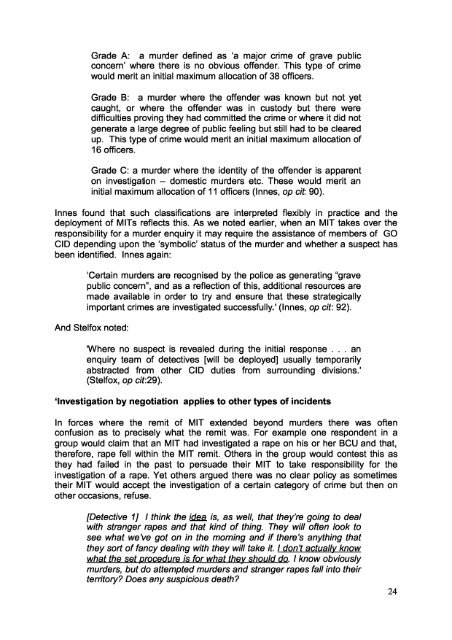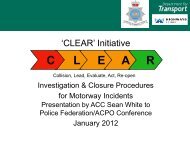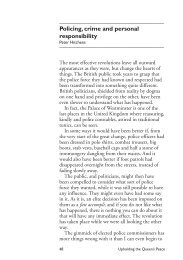LOSING THE DETECTIVES: VIEWS FROM THE ... - Police Federation
LOSING THE DETECTIVES: VIEWS FROM THE ... - Police Federation
LOSING THE DETECTIVES: VIEWS FROM THE ... - Police Federation
Create successful ePaper yourself
Turn your PDF publications into a flip-book with our unique Google optimized e-Paper software.
Grade A: a murder defined as ‘a major crime of grave public<br />
concern’ where there is no obvious offender. This type of crime<br />
would merit an initial maximum allocation of 38 officers.<br />
Grade B: a murder where the offender was known but not yet<br />
caught, or where the offender was in custody but there were<br />
difficulties proving they had committed the crime or where it did not<br />
generate a large degree of public feeling but still had to be cleared<br />
up. This type of crime would merit an initial maximum allocation of<br />
16 officers.<br />
Grade C: a murder where the identity of the offender is apparent<br />
on investigation – domestic murders etc. These would merit an<br />
initial maximum allocation of 11 officers (Innes, op cit: 90).<br />
Innes found that such classifications are interpreted flexibly in practice and the<br />
deployment of MITs reflects this. As we noted earlier, when an MIT takes over the<br />
responsibility for a murder enquiry it may require the assistance of members of GO<br />
CID depending upon the ‘symbolic’ status of the murder and whether a suspect has<br />
been identified. Innes again:<br />
‘Certain murders are recognised by the police as generating “grave<br />
public concern”, and as a reflection of this, additional resources are<br />
made available in order to try and ensure that these strategically<br />
important crimes are investigated successfully.' (Innes, op cit: 92).<br />
And Stelfox noted:<br />
'Where no suspect is revealed during the initial response . . . an<br />
enquiry team of detectives [will be deployed] usually temporarily<br />
abstracted from other CID duties from surrounding divisions.'<br />
(Stelfox, op cit:29).<br />
‘Investigation by negotiation’ applies to other types of incidents<br />
In forces where the remit of MIT extended beyond murders there was often<br />
confusion as to precisely what the remit was. For example one respondent in a<br />
group would claim that an MIT had investigated a rape on his or her BCU and that,<br />
therefore, rape fell within the MIT remit. Others in the group would contest this as<br />
they had failed in the past to persuade their MIT to take responsibility for the<br />
investigation of a rape. Yet others argued there was no clear policy as sometimes<br />
their MIT would accept the investigation of a certain category of crime but then on<br />
other occasions, refuse.<br />
[Detective 1] I think the idea is, as well, that they’re going to deal<br />
with stranger rapes and that kind of thing. They will often look to<br />
see what we’ve got on in the morning and if there’s anything that<br />
they sort of fancy dealing with they will take it. I don’t actually know<br />
what the set procedure is for what they should do. I know obviously<br />
murders, but do attempted murders and stranger rapes fall into their<br />
territory? Does any suspicious death?<br />
24
















